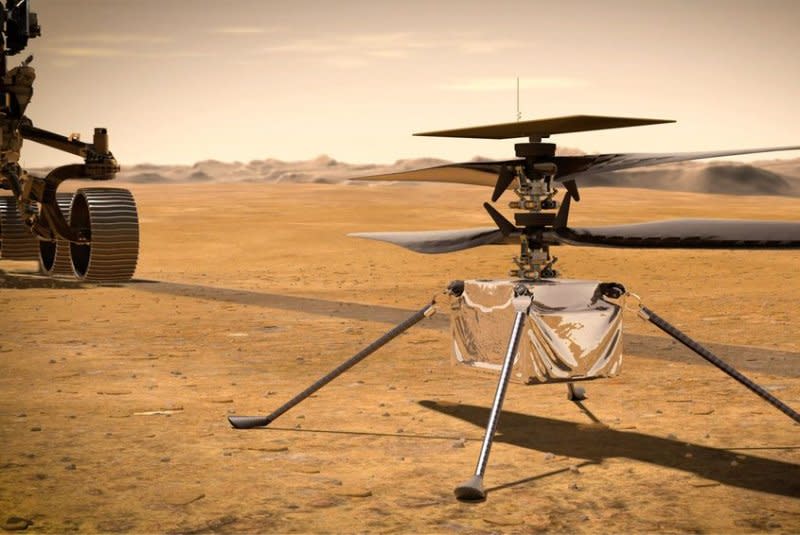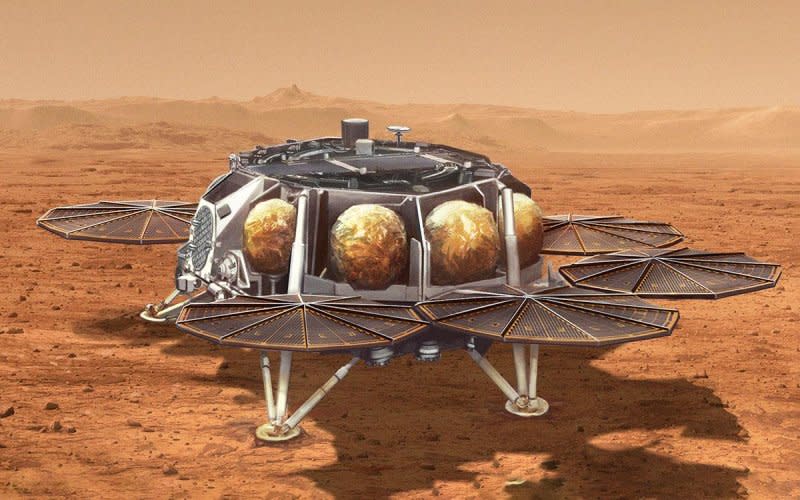Ingenuity, the tiny Mars helicopter that could, will keep flying

CAPE CANAVERAL, Fla., Aug. 30 (UPI) -- Ingenuity, the tiny $80 million helicopter that has hovered over Mars 55 times since April 2021, will continue mapping the planet's surface as long as it can still fly, the former team lead at NASA's Jet Propulsion Laboratory in Pasadena, Calif., told UPI.
Ted Tzanetos, whose team turned 4-pound Ingenuity into the little helicopter that could, now manages creation of a recovery helicopter to gather geological samples of Martian air, soil and rocks that the Perseverance rover has been collecting since landing with Ingenuity aboard on the Red Planet in February 2021.
"We've taken our old Ingenuity engineering model and we've pushed it to its limits," Tzanetos said in a phone interview. "We're in the process now of building our first full-scale prototype for chamber testing in September."
That will be one of many trials to ensure lightweight helicopters can assist retrieving Martian samples to be loaded into a rocket-propelled container ready to carry them to Earth.
The #MarsHelicopter is ready for Flight 56!
Ingenuity will take off no earlier than Aug. 25, heading northwest it will cover 418 meters in about 136 seconds. https://t.co/3b0M5pb0QL pic.twitter.com/A9gfas3I1A— NASA JPL (@NASAJPL) August 25, 2023

NASA intends to launch a spacecraft called the Sample Retrieval Lander in 2028, which will settle on Mars as close as possible to the Jezero Crater and river delta, where Perseverance touched down.
The space agency's original plans involved using Perseverance in a primary role, transferring the geological payload directly to the retrieval lander. But that would mean a lot of maneuvering for the rover and its robotic arm, said Joshua Anderson, Ingenuity's team lead at JPL.

And a mobility problem affecting either system could spell disaster for the $2 billion mission.
Mars watchers may have noticed Ingenuity's seeming disappearance in April, after the helicopter surpassed expectations about its robustness, resiliency and reliability. Its successes gradually convinced managers they already had the prototype needed for the sample recovery helicopters.

After the mini chopper went silent April 26, controllers feared the worst -- that Ingenuity was disabled or destroyed or that the harsh Mars temperatures killed its batteries. While they were thoroughly pleased with its exceptional performance, it was hard for them to let go.
But then, on June 28, Ingenuity phoned home via the Perseverance rover -- the first word from the chopper since it went silent on the floor of the Jezero Crater after its 52nd flight.

But more drama lay ahead. The 53rd flight, on July 22, at 74 seconds, was far shorter than the planned 136 seconds to collect surface imagery of a rocky outcrop.
"Since the very first flight, we have included a program called 'LAND_NOW' that was designed to put the helicopter on the surface as soon as possible if any one of a few dozen off-nominal scenarios was encountered," Tzanetos said.
"During Flight 53, we encountered one of these, and the helicopter worked as planned and executed an immediate landing."
Flight 54 on Aug. 3, a 25-second up-and-down hop, was intended to determine what happened on the previous truncated flight and gave controllers confidence that Integrity had more life left in it.
"The Aug. 3 flight has proved that our baby is healthy and ready to keep flying," Tzanetos said. "That's important for the sample recovery helicopters because it is a safety net feature that now we know works. We know that the code execution task works well."
Then, Ingenuity flew for the 55th time Aug. 12, covering a wide bit of ground in its surveying mission.
"Ingenuity has now successfully flown on Mars 55 times! On its latest flight, the #MarsHelicopter flew 866 feet (264 m) for 143 seconds at a height of 32.8 feet (10 m)," JPL wrote via X, formerly Twitter, on Aug. 16.
The little helicopter has now covered 41,024 feet of ground and stayed aloft for nearly 98 minutes on its 55 flights, mission team members wrote on the chopper's flight log. And a repositioning 56th flight is imminent.
With their problem solved, engineers continue their work to show how helicopters could play a critical role in the sample recovery operations, Anderson said.
"Demonstrating coordination between Perseverance and Ingenuity remains a main goal," he said. That's how the Mars copters will play a primary role, rather than assist as backups.
New ones will be slightly larger and carry more sophisticated instruments than Ingenuity's, working in coordination with Perseverance to identify and verify the location of containers that the rover has been storing around the landing site.
The aircraft will pick up a single sample container at a time, deliver it to the Sample Retrieval Lander, fly back to get the next one, deliver it, and so on -- a task for both of Ingenuity's twin successors.
Most people, "even at JPL, wondered about flying a helicopter in an atmosphere with a pressure that's barely 0.7% of Earth," Anderson said. "There was a huge question of whether you could actually do something useful with a helicopter on Mars."
As it turned out, propeller blades spinning between 2,400 and 2,900 rpm did the trick. They are not just run-of-the-mill blades; they are made of carbon fiber specifically designed for the Martian environment.
Given Earth's greater atmospheric density, helicopter blades run between 225 and 550 rotations per minute, depending on aircraft shape and size.
If Ingenuity's propeller blades were to rotate in Earth's atmosphere, they would shatter within seconds. At a spin rate six times higher than that of standard helicopters, the edges would reach supersonic speeds, and the vibrations would be strong enough to cause obliteration.
NASA chose to explore the Jezero Crater's vicinity because billions of years ago, water was likely abundant and temperatures favorable to the presence of microscopic living organisms. And traces of microbial life can conserve for billions of years, especially in a fossilized state.
That would make for a historic finding.
It almost happened in 1997, when a Martian meteorite found in Antarctica showed possible evidence of past life. Even the White House became involved, with former President Bill Clinton announcing the discovery.
Microscope scans showed virus-size markers that could have resulted either from inorganic or organic chemical reactions. In the end, however, scientists acknowledged their investigations and results were inconclusive.
For the sample recovery mission, "We would arrive on Mars in 2030, and then it's a two-year cruise," Tzanetos said.
"So, launch in '28, arrive in 2029 or '30. Then, hopefully, the tubes would come back to Earth within two years of that, in 2032 or '33."
But it won't necessarily be easy, and the mission will require help from the European Space Agency.
"ESA is working with NASA to explore mission concepts for an international Mars Sample Return campaign," the agency said. "Several launches will be necessary to accomplish landing, collecting, storing and finding samples and delivering them to Earth."
It added: "Returning samples to Earth from Mars is expected to be the most complex robotic space flight campaign ever attempted."

